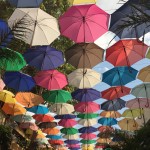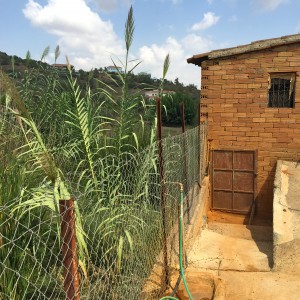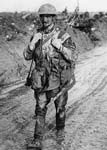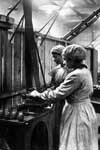Women’s Voices from the Scottish Borders
November 16, 2015 by User deactivated | 0 comments
Remembering domestic servants, shorthand typists, cinema pianists and suffragettes: new soundbites from the Ian Landles Oral History Archive
We’re releasing some more soundbites from the Ian Landles Oral History Archive this week. This time we’re showcasing the stories of women from the Scottish Borders.
You’ll hear from Mrs Oliver (b.1901) about her experiences as a pianist working in cinemas in Hawick – ‘The Piv’ and ‘The Wee Thee’ – providing the soundtrack for silent movies. Mrs Oliver also worked as a shorthand typist and she talks about this in a second soundbite. We learn how she perfected her shorthand by sitting in the back of church during services and noting down the sermons.
Other women talk about their memories of the suffrage movement in the years leading up to the First World War. Mrs Stewart (b.1881) remembers suffragettes coming to Hawick and Mrs Thomson tells us how the activists gained a reputation amongst the locals: ‘they come to burn hooses doon’.
- Cinema
- Shorthand Typists
- Domestic Servants
- Suffragettes
A number of women in the Borders worked in service in the early 20th century at the many country houses and estates across the region. Catherine McLeish (b.1902) and Meg Wilson (b.1893) share their experiences.
Follow us on Twitter and watch our Twitterfeed from tomorrow to catch these soundbites.
The Ian Landles Archive is a series of interviews and sound recordings collected by local historian Ian Landles between the 1960s and 2010. The collection, originally started in order to preserve the memories of local men who had fought in World War One, also contains testimonies from local women and material on The Hawick Common Riding, poetry, music, the railways, farming life and mill life. The original full interviews are held on audio cassette tape by Scottish Borders Council Archive Services at the Heritage Hub in Hawick. To listen to all interviews from the Ian Landles Archive currently held on Scran click here.
Images © Aberdeen City Council, Hulton Getty, Dalmellington & District Conservation Trust | Licensor Scran








 aturday 19th September 2015. After such a full day in the capital, we stayed local and visited the neighbouring village of Kato Drys. Firstly, we went to the top of Sotira hill, behind Lefkara to get panoramic view across the Larnaca District and surrounding landscape and visited the tiny church perched there. It had some charming icons dating from the early C20th.
aturday 19th September 2015. After such a full day in the capital, we stayed local and visited the neighbouring village of Kato Drys. Firstly, we went to the top of Sotira hill, behind Lefkara to get panoramic view across the Larnaca District and surrounding landscape and visited the tiny church perched there. It had some charming icons dating from the early C20th.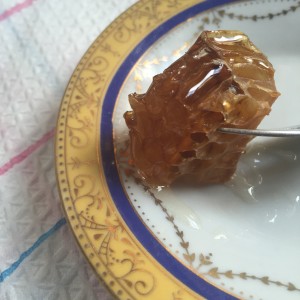



 We made an early morning visit to the silversmiths in Lefkara and learned about their processes, which are mostly mechanised but involved all sorts of materials, rubber, wax, plaster and of course silver. The workshops were very interesting but we could not linger. Adriana had to get us to the airport for our incredible journey home to Glasgow, via Stansted. I’m glad to say on our way to Paphos she took us to see Aphrodite’s Rock, the ideal way to say goodbye & ευχαριστώ
We made an early morning visit to the silversmiths in Lefkara and learned about their processes, which are mostly mechanised but involved all sorts of materials, rubber, wax, plaster and of course silver. The workshops were very interesting but we could not linger. Adriana had to get us to the airport for our incredible journey home to Glasgow, via Stansted. I’m glad to say on our way to Paphos she took us to see Aphrodite’s Rock, the ideal way to say goodbye & ευχαριστώ


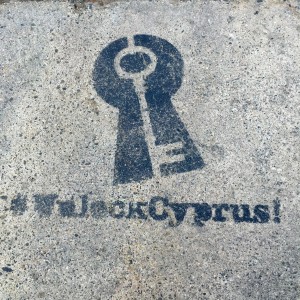 earing the capital city of Cyprus I was surprised to see a giant Turkish Cypriot flag painted onto the side of the Kyrenia Mountains – what a statement. Following the conflict of 1974, the Turkish Republic of Northern Cyprus TRNC became a self-declared state, however it is only recognised by Turkey. The political and military dispute in Cyprus remains unresolved and the island continues with life, divided. The Green Line runs 112 miles from east to west across the island, splitting families, property and communities.
earing the capital city of Cyprus I was surprised to see a giant Turkish Cypriot flag painted onto the side of the Kyrenia Mountains – what a statement. Following the conflict of 1974, the Turkish Republic of Northern Cyprus TRNC became a self-declared state, however it is only recognised by Turkey. The political and military dispute in Cyprus remains unresolved and the island continues with life, divided. The Green Line runs 112 miles from east to west across the island, splitting families, property and communities.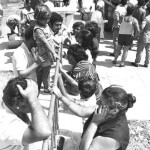
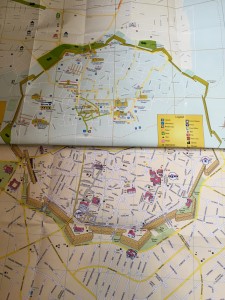 Nicosia is a vibrant & sophisticated city, with a buzz in the streets. Trendy shops & coffee houses lined the artists’ quarter. After a little pick-me-up in the form of some Cyprus coffee, μέτριο for me please, we neared the Green Line. Passports at the ready we crossed over to the north side of the city through two sets of border control, Greek & Turkish. It was easy enough the pass through, plenty of tourists and locals alike were going to & fro. Yet, CCTV was evident, uniformed armed guards were on duty & signage warned us that photography was strictly forbidden in this narrow
Nicosia is a vibrant & sophisticated city, with a buzz in the streets. Trendy shops & coffee houses lined the artists’ quarter. After a little pick-me-up in the form of some Cyprus coffee, μέτριο for me please, we neared the Green Line. Passports at the ready we crossed over to the north side of the city through two sets of border control, Greek & Turkish. It was easy enough the pass through, plenty of tourists and locals alike were going to & fro. Yet, CCTV was evident, uniformed armed guards were on duty & signage warned us that photography was strictly forbidden in this narrow


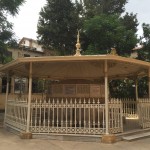
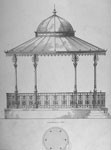
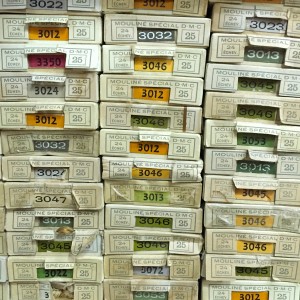 Not only is she a successful businesswoman, but Senaye also works on bi-communal projects, using craft to bring together Cypriots from both sides of the divide and trains up young apprentices too. Thereby generating hope for the future and breaking down barriers. Later we visited the amazing Yagcioglu haberdashery, which stocked the all-important
Not only is she a successful businesswoman, but Senaye also works on bi-communal projects, using craft to bring together Cypriots from both sides of the divide and trains up young apprentices too. Thereby generating hope for the future and breaking down barriers. Later we visited the amazing Yagcioglu haberdashery, which stocked the all-important 